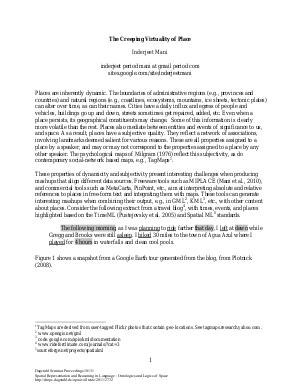The Creeping Virtuality of Place
Author Inderjeet Mani
-
Part of:
Volume:
Dagstuhl Seminar Proceedings, Volume 10131
Part of: Series: Dagstuhl Seminar Proceedings (DagSemProc) - License:
 Creative Commons Attribution 4.0 International license
Creative Commons Attribution 4.0 International license
- Publication Date: 2011-01-04
File

PDF
DagSemProc.10131.5.pdf
- Filesize: 372 kB
- 5 pages
Document Identifiers
Subject Classification
Keywords
- Place subjectivity dynamicity
Metrics
- Access Statistics
-
Total Accesses (updated on a weekly basis)
0PDF Downloads0Metadata Views
Abstract
Places are inherently dynamic. They also mediate between entities and events of significance to us, and space. They reflect a network of associations, involving landmarks deemed salient for various reasons. These are all properties assigned to a place by a speaker, and may or may not correspond to the properties assigned to a place by any other speaker. As a result, places have a subjective quality. These properties of dynamicity and subjectivity present interesting challenges when producing mashups that align different data sources. I propose addressing this by assuming that entities, following Hornsby & Egenhofer (2000), have histories, namely sequences of time intervals when they are predicated to exist. Places are entities with spatial properties that include topological relationships to other places, represented in terms of RCC-8 or the 9-intersection calculus, as well as distance and orientation relations. This spatio-temporal integration can avail of existing annotation schemes for space and time in natural language, but it leaves some open issues related to the representation of subjectivity.
Cite As Get BibTex
Inderjeet Mani. The Creeping Virtuality of Place. In Spatial Representation and Reasoning in Language : Ontologies and Logics of Space. Dagstuhl Seminar Proceedings, Volume 10131, pp. 1-5, Schloss Dagstuhl – Leibniz-Zentrum für Informatik (2011)
https://doi.org/10.4230/DagSemProc.10131.5
BibTex
@InProceedings{mani:DagSemProc.10131.5,
author = {Mani, Inderjeet},
title = {{The Creeping Virtuality of Place}},
booktitle = {Spatial Representation and Reasoning in Language : Ontologies and Logics of Space},
pages = {1--5},
series = {Dagstuhl Seminar Proceedings (DagSemProc)},
ISSN = {1862-4405},
year = {2011},
volume = {10131},
editor = {John A. Bateman and Anthony G. Cohn and James Pustejovsky},
publisher = {Schloss Dagstuhl -- Leibniz-Zentrum f{\"u}r Informatik},
address = {Dagstuhl, Germany},
URL = {https://drops.dagstuhl.de/entities/document/10.4230/DagSemProc.10131.5},
URN = {urn:nbn:de:0030-drops-27326},
doi = {10.4230/DagSemProc.10131.5},
annote = {Keywords: Place subjectivity dynamicity}
}
